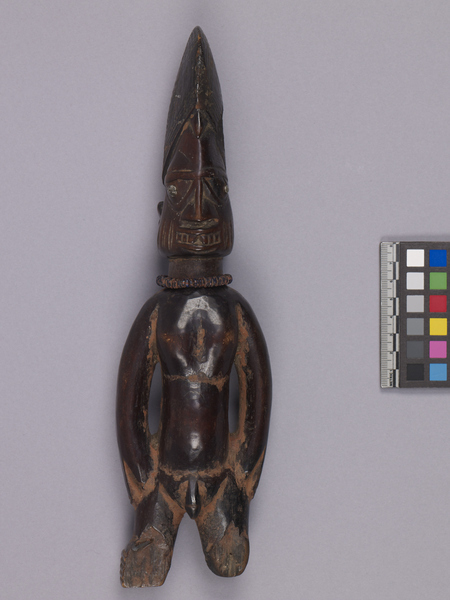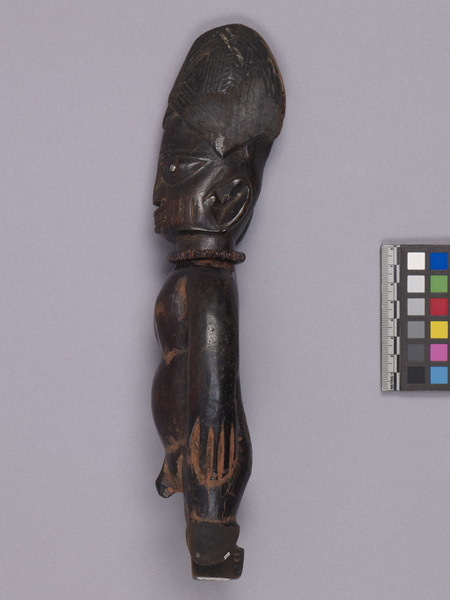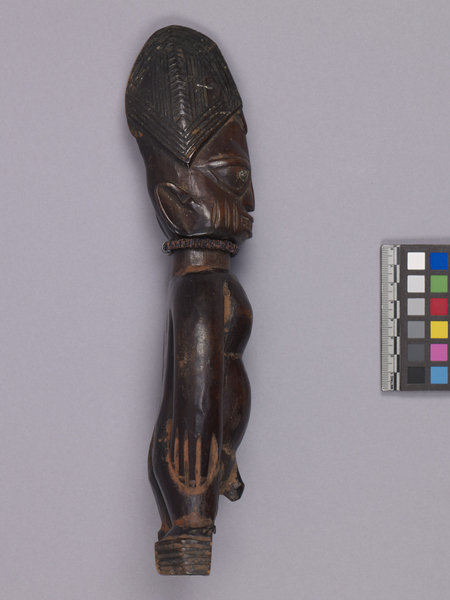Figure Item Number: 3055/3 from the MOA: University of British Columbia




Description
Standing wood figure (ibeji) of a male; arms curve to connect with thighs. Long fingers with nails are carved on each hand. Slightly protruding stomach and chest are smooth without any decoration, as is back. Phallus protrudes from mid-section. Angular foot is carved with horizontal lines. Face is highly stylized with open mouth showing square teeth, 3 vertical lines on each cheek, angular nose, long ears flattened against head, and open eyes with metals studs for pupils. Figure is wearing a necklace strung with mostly blue, white and red beads. Central beads are white and yellow and black and yellow. Headdress tapered to thin point above head and is carved with diagonal lines and triangles. Rounded triangle drops over forehead.
History Of Use
Based on the sacred duality of "twoness" (èjìwàpò) found in nature, such as life/death, right/left, male/female, twins are understood as bringers of wealth and blessings to their family if they are satisfied, or misfortune if they are dissatisfied. As a result, living twins are treated with a high degree of respect and favouritism. When a twin, or both, dies the parents consult a diviner (babalawo), who communicates the desires of the deceased; small commemorative wooden figures (ère ìbejì) are carved to honour and represent them. Yorubas believe that twins share a soul, so the family was to treat the figure as they would if the twin was still physically present. As a result, the twin was fed, washed and cared for. Rather than realistic representations, ère ìbejì are idealized forms. They are often decorated with cowrie shells, beaded or metal bracelets, necklaces, and anklets, and cosmetics, such as osun (camwood powder), indigo, and efun (white chalk). By the mid-19th century, Christianity and Islam began to influence the design of ère ìbejì. Yoruba Muslims sometimes commissioned ere ibeji with carved torah, or leather packets containing quotations from the Quran, while Yoruba Christians incorporated Virgin Mary medals or crucifixes. In the mid-20th century, manufactured or plastic dolls began to replace the traditional ère ìbejì. Today, these dolls, in addition to the use of photographs, continue to sustain the ère ìbejì tradition.
Iconographic Meaning
The facial scarification on both cheeks (ila, or “lineage face mark”) indicates a specific community to which the represented deceased twin belongs. Based on the non-typical style, this figure is from southwestern and adjacent areas of Yorubaland.
Item History
- Made in Nigeria
- Owned by Alan R. Sawyer before 2002
- Owned by Erika H. Sawyer before April 16, 2014
- Received from Erika H. Sawyer (Seller) and Museum of Anthropology Acquisitions Budget (Funding source) on April 16, 2014
What
Who
- Culture
- Yoruba
- Previous Owner
- Alan R. Sawyer and Erika H. Sawyer
- Received from
- Erika H. Sawyer (Seller) and Museum of Anthropology Acquisitions Budget (Funding source)
Where
- Holding Institution
- MOA: University of British Columbia
- Made in
- Nigeria
When
- Ownership Date
- before 2002 and before April 16, 2014
- Acquisition Date
- on April 16, 2014
Other
- Item Classes
- carvings & sculpture
- Condition
- fair
- Accession Number
- 3055/0003